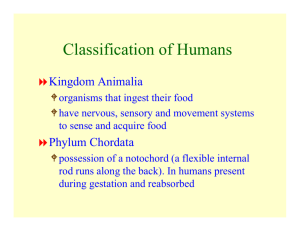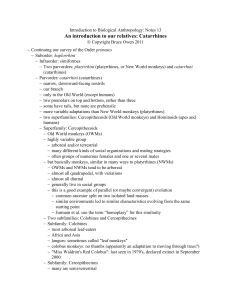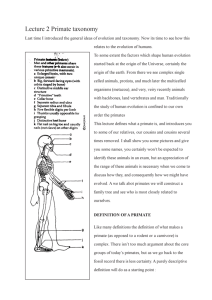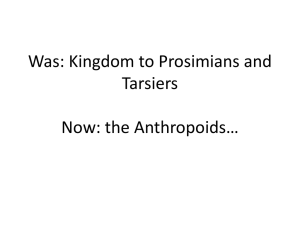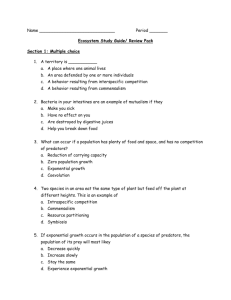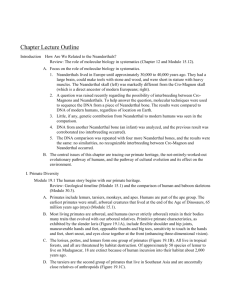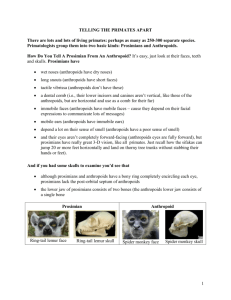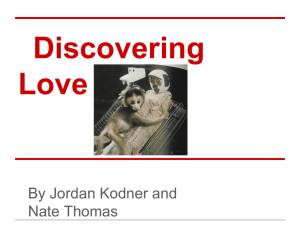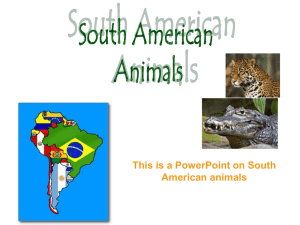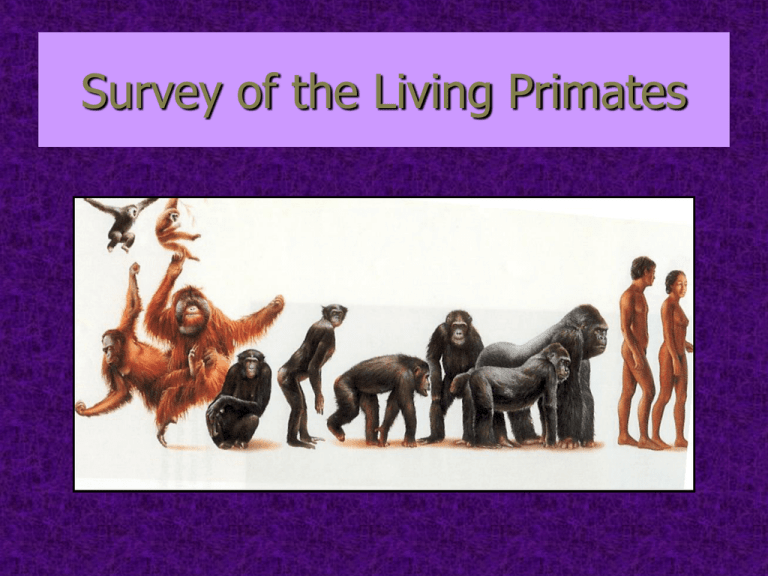
Survey of the Living Primates
Two Suborders:
1.
Prosimians
2.
Includes lemurs, lorises, bush babies,
tarsiers
Anthropoids
Includes monkeys, apes and humans
This division means that the prosimians have more traits/adaptations
in common with each other than they do with the Anthropoids.
Likewise, monkeys, apes and humans share more in common with
each other than any of them do with the more primitive prosimians
The Prosimians
Characteristics
A.
1.
2.
3.
Most primitive (ancestral)
Small bodied
Sensory anatomy different
a.
More reliant on olfaction (smell) as evidenced by:
i.
ii.
iii.
b.
Nocturnal
i.
ii.
4.
5.
6.
Long snouts
Moist, fleshy nose
Mark territory with scent
Large eyes (not protected by bony anatomy)
No color vision
Insectivores (all teeth are very sharp, more specialized)
Solitary (helps them to avoid attention of predators)
Claws instead of nails
PROSIMIANS, cont.
B.
Lemurs – largest group of prosimians
1.
2.
3.
4.
5.
6.
Found only on island of Madagascar
Evolved independently from other
prosimians
DIURNAL (no competition w/other primates)
Omnivorous
Arboreal quadrupeds, vertical clingers,
leapers
Ring tailed lemur is terrestrial
PROSIMIANS, cont.
C.
D.
Lorises - small bodied, nocturnal, slow
quadrupedal climbers
Bush babies – extremely agile vertical
clinger & leaper
Tarsiers
E. Center of classification debate
•
a.
b.
c.
d.
e.
f.
Has characteristics of both prosimians &
anthropoids
Dry nose
Color vision (limited)
Carnivorous – eats lizards, frogs, insects
Form monogamous pairs
Park young in trees while foraging
Can rotate head 360°
Tarsier video quick clip
The Anthropoids:
Monkeys, Apes & Humans
1.
2.
3.
4.
5.
6.
7.
Large body size
Large brains
Diurnal
Enhanced color vision
Live in social groups
Primarily fruit eaters
Dry noses
Divided into New World Monkeys (Platyrrhines) and the
Old World Monkeys (Catarrhines)
New World Monkeys, Cont.
Marmosets and
tamarins
Most primitive NWM
Very small
Claws
Insectivores/Gum
Use scent marking
Twin births
Monogamous pairs
Highly endangered
species
New World Monkeys
(Platyrrhines)
A.
Characteristics
1.
2.
3.
4.
5.
6.
7.
Found only in southern Mexico, Central
America and South America
Widely spaced, outward facing nostrils
Prehensile (grasping) tail
Three premolars (36 teeth total)
Almost exclusively arboreal
Quadrupedal
Capuchin monkeys use tools to crack nuts
Old World Monkeys
(Catarrhines)
A.
Characteristics
1.
2.
3.
4.
5.
Wide geographical distribution
Downward facing nose, closely spaced
nostrils
Sexually dimorphic (differences in
body/tooth size between males & females)
Two premolars (32 teeth total)
Have “sitting pads” (ischial callosities)
Two main groups: The Cercoptihecines & the
Colobines
Old World Monkeys
(Catarrhines)
A.
Cercopithecines = Baboons,
Macaques, and Guenons
1.
2.
Majority found in Africa
Omnivorous
a.
3.
4.
Cheek pouches to store food
Quadrupedal
Baboons most terrestrial
a.
b.
Quadrupedal
Large, complex social
groups called troops
Catarrhine (Old World)
Monkeys, Cont.
B. The Colobines = African colobus
monkeys and Asian langur monkeys
1.
Leaf-eaters
a.
b.
c.
2.
Sharp cusped molars
Specialized stomach for digesting cellulose
“Banquet feeders” – stay in one place
Arboreal quadrupeds
Summary:
Differences between NWM & OWM
New World Monkeys
Flat, widely spaced nostrils
Prehensile tails
Three premolars (36 teeth)
Mostly arboreal
Old World Monkeys
Downward pointing, closely
spaced nostrils
Sitting pads
Two premolars (32 teeth)
The Hominoids:
Apes & Humans
Increased brain size & intelligence
Larger body size
Do not have tails
Increased social complexity
Possess rotating, suspensory shoulders
that allows arm-hanging & arm-swinging
(brachiation)
The Hylobatidae Family
(Lesser Apes)
A.
Gibbons & Siamangs
1.
2.
3.
4.
5.
6.
7.
Inhabit southeastern tropical areas of Asia
Smallest of apes
Entirely arboreal
Move by brachiation
Highly frugivorous
Very vocal & territorial
Monogamous pair with dependent offspring
The Pongidae Family
(The Great Apes)
Orangutans: The Asian Ape
- Name means “person of the forest”
1.
Found only in Borneo & Sumatra
2.
Fully arboreal
3.
Omnivorous; Use sticks to get termites or honey
(Sumatran orangs)
4.
Pronounced sexual dimorphism
5.
Solitary; do not live in social groups
6.
Extremely endangered
A.
B. Gorillas
1.
2.
Largest of all living primates
Live in forested regions across central &
western Africa
a.
3.
Marked sexual dimorphism
a.
4.
Lowland and Mountain gorillas
Males = 400 lbs.; Females = 150-200 lbs.
Vegetarian
B. Gorillas (Continued)
5.
6.
Quadrupedal knuckle-walkers when on
ground
Live in social groups
a.
7.
Dominant male silverback is leader
Mountain gorilla population =
approximately 600
C. Chimpanzees
(Pan troglodytes)
1.
2.
Found in forests of equatorial
Africa
Live in large, fluid communities
a.
b.
c.
3.
4.
Occupy a territory defended by males
Centered around bonded males
Females emigrate out when they reach
sexual maturity
Arboreal & terrestrial
Slight sexual dimorphism
C. Chimpanzees (Cont.)
5.
6.
7.
8.
Knuckle-walkers, brachiators, &
sometimes bipedal
Omnivorous
Hunt for meat
Make & use tools
D. Bonobos (Pan paniscus)
1.
2.
3.
4.
Found only in the Congo
More slender than chimps
More arboreal than chimps
Large, fluid communities
a.
b.
5.
Center around bonded males & bonded
females
Can be female dominant
Less aggressive & excitable than chimps
D. Bonobos, cont.
6.
7.
More prone to bipedality
Sexual practices
a.
b.
c.
Sex outside of estrus
Use to form alliances & gain acceptance
Use to restore harmony & relieve tension
E. The Hominids: Humans
1.
2.
3.
4.
5.
6.
Only living representative of Hominid
family
Primate heritage evident in overall
anatomy & genetic make up
Teeth similar to that of apes
Vision/sight predominant sense
Flexible limbs, grasping hands
Omnivorous
What separates humans from
non-human primates?
Humans have culture – used as primary
means of adaptation
Humans can produce speech
Sex not confined to female’s most fertile
period
Humans are the only true habitual
bipedal mammals
Primate Family Tree
Anthropoids
New World
Monkeys
Prosimians
Old World
Monkeys
Cercopithecines & Colobines
Hominoids
Hylobatidae
(Lesser Apes)
Pongidae
(Great Apes)

